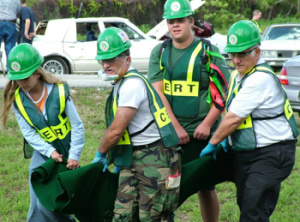
There is no way to assure your readiness than to test yourself with a scenario as real as possible.
In about three weeks we are doing a preparedness drill in my area, I am doing some teaching there. Emily R. is promoting it to the neighbors and has secured the use of a field to gather in. The scenario is an earthquake and since we live near a major fault this is quite appropriate. We are gathering on the first evening, to help each other and to assess the situation, the following day we would go around and assess damage to homes to see what is safe and what isn’t by utilizing information and training from the CERT program.
Below is a rough guide we are using to run the scenario. It will be fleshed out a little more in the coming weeks, but this would be a guide to get started.
Neighborhood Earthquake Preparedness Drill
Location: Russell Property
Scenario: Earthquake damages homes and structures, everyone to meet at Russell’s to set up temporary camp for a few days while damages are assessed, homes inspected, repairs made. Scenario covers first night and following day. People to bring their 72 hour kits or Bug Out Bags for each family member.
Basic Activity Outline
Greeters’ duty:
- Stationed at entry area to meet people as they arrive
- Resources cataloged for rough idea of available food, medical, water, shelter, heating/cooking, rescue, etc.
- Note those who have completed CERT or other disaster training that can assist
- Also make list of skills of those gathering, outdoor cooking, shelter building, medical, construction/engineering, etc.
Shelter
- At homes, check for gas leaks, shut off gas as needed.
- Set up shelters as needed with materials available, have someone assigned to help coordinate this activity, could use vehicles themselves for shelter, tarps could be tied between them for shade or cooking areas as needed.
- Check for electrical utilities in service.
- Find those with skills to start looking at houses starting next day to determine livability, what repairs need to be made.
Fire
- Determine cooking capabilities, stoves, fuel, fire, pots, and pans.
- If possible have a fire for comfort if nothing else.
Water
- Check for water supplies brought with group
- If some have barrels or buckets of water in storage at homes that is safe to get at, bring some to meeting site to help with the group.
Medical
- Medical care and such for first night. Utilize those with medical training to take care of any injured, others to assist as needed.
- Greeters could tie colored ribbons around arms of various people as they arrive indicating certain injuries. Simulate taking care of them and their families.
- Assume all people have to be taken care of locally no hospital or outside medical care available.
Food
- Have persons assigned to help with cooking as needed.
- Depending on what resources are available, may not need cooking for first night.
- Plan cooking for Saturday activities
Social/Rescue
- Note any who have radio capability with which to stay in touch with other groups and city authorities.
- Have someone assigned to help settle families in organized fashion.
- Set up reporting of status to community/church officials as indicated in local emergency protocol
- Tag homes after inspection as safe/unsafe according to CERT guidelines
- Plan group assistance to help with repairing damages and making homes livable again
Until next time this is Perry Peacock, “Simplifying Survival”



